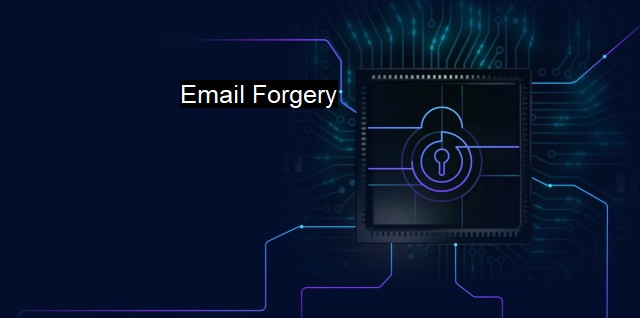What is Email Forgery?
The Dangers of Email Forgery: Understanding Email Spoofing and Phishing Tactics to Protect Your Data and Security
Email forgery, also referred to as 'spoofing', is a popular cybercrime that targets naive Internet users and corporate networks around the globe. Predicated on the basic premise of masquerading as a legitimate entity to deceive the recipient, email forgery has become increasingly prevalent in the digital dispersion of scam, fraud, and phishing attacks, making it a top concern in the arena of cybersecurity and antivirus software development.Comprehending email forgery involves getting familiar with a couple of key technical terms. 'Mail from', for instance, refers to a command used in SMTP - Simple Mail Transfer Protocol, which is the basic protocol responsible for email dispatch across the Internet. It is imperative to note however anomaly it may seem, there is little to no verification done when the 'mail from' command gets put into operation. This means, anyone intending to commit email forgery can very well input a fake or unauthorized address, and on the receiving end, the message will appear as if it had emanated from the original, legitimate address. Coupled with 'social engineering', tactics where attackers study their victims regulations of their usual correspondents and emulate them in the deceitful emails they dispense, the illusion escalates and becomes significantly tougher to discern.
In a vast majority of instances, the objective of email forgery is to solicit sensitive information from unsuspecting recipients - an illegal endeavor widely known as 'phishing'. Capitalizing on the target’s trust of the counterfeited email address, the attackers prompt them into yielding confidential details such as usernames, passwords, and credit card numbers. Alternatively, email forgers might navigate their victims towards malware-laden websites or directly infect their devices by appending malicious attachments to their spoofed emails.
There emerges an intrinsic link between email forgery and malware upon stating these typical exploitations. Malware is a term embodying a multitude of malicious software, which includes computer viruses, worms, ransomware, spyware, and more. If the forgery victim so happens to engage with the malicious contents or links accompanying the spoofed email, their device may get infected, leading to additional damage such as data theft, espionage, and even system hijack.
The world of cybersecurity thus responds to email forgery through a mixture of preventative measures and post-incident procedures. These include sophisticated protocols for email authentication such as the SPF - Sender Policy Framework, which aids in verifying if the incoming mail is coming from a legitimate server as it claims to be. Where antivirus however it is even more ingrained is in dealing with the malicious payloads transported through this type of fraud. Antivirus software inspects attachments, filters malicious links, and empowers users to detach or quarantine threats for safe eradication.
Despite the formidable control mechanisms in place, email forgery continues to loom as a considerable concern within cybersecurity circles. Antivirus solutions still heavily rely on up-to-date virus definitions to detect and neutralize menaces, thus constantly playing catch-up with novel strains of malware. Under these circumstances, user education assumes paramount importance in countering such threats. A well-informed user, who stays dutifully mindful of the potential red flags attached to fraudulent emails, operates as the ideal first line of defense against email forgery and associated impacts.
Email forgery represents a significant cybersecurity issue, utilizing diversified deceit strategies to con victims into providing sensitive data or facilitating malware introduction into their system. Cybersecurity and antivirus industries work diligently to deter forgery attacks via advanced technological means and educating users about safe online practices. Through combined efforts, it is hoped that the negative impact of this sinister trick can be alleviated.

Email Forgery FAQs
What is email forgery?
Email forgery, also known as email spoofing or phishing, is the act of impersonating someone else’s email identity in order to carry out fraudulent activities such as stealing personal information or money.What are some common types of email forgery attacks?
Common email forgery attacks include spear phishing, CEO fraud, and domain spoofing.How can I protect myself against email forgery attacks?
To protect yourself against email forgery attacks, make sure to verify the email address of the sender, be wary of unexpected or urgent requests for information, and use antivirus software and firewalls to block suspicious emails.What should I do if I suspect an email forgery attack?
If you suspect an email forgery attack, do not respond or click on any links in the message. Instead, report the incident to your IT department or the appropriate authorities and take steps to secure your personal information and accounts.| | A | | | B | | | C | | | D | | | E | | | F | | | G | | | H | | | I | | | J | | | K | | | L | | | M | |
| | N | | | O | | | P | | | Q | | | R | | | S | | | T | | | U | | | V | | | W | | | X | | | Y | | | Z | |
| | 1 | | | 2 | | | 3 | | | 4 | | | 7 | | | 8 | | |||||||